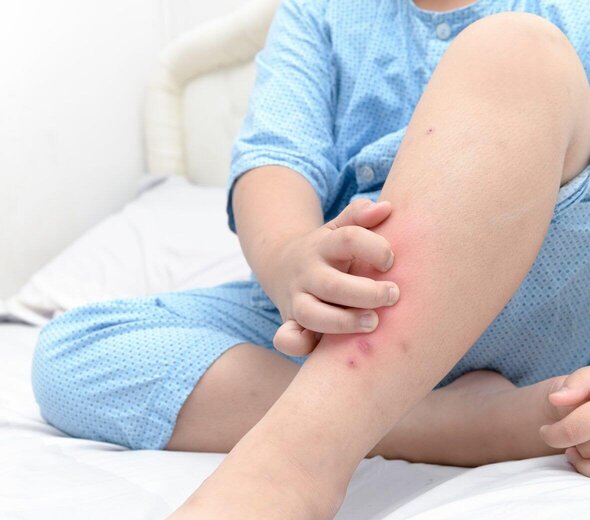

Walks outside are pleasant and healthy for you and for the baby. Sometimes, however, they may end in reddening the baby's skin, pain and tears. I will give you some tips how to handle mosquito, wasp, tick, gnat and ant bites.
Before you go for a summer walk, bath the child - mosquitos are particularly attracted to the smell of sweat. Put a mosquito net on the pram/buggy. When you plan more active time (the child will also be out of the buggy), buy in a pharmacy a special infant-intended formula protecting against insect bites. Spray the child's clothes. Do not use sprays for adults, because they contain chemical substances that can be harmful and irritating to the baby's skin. You can also sprinkle the child's clothes with vanilla food flavouring. It is safe and has a nice smell.
Ticks may be encountered especially during walks in a forest or a meadow. They often fall down from trees or lurk in long grass. They feed on human and animal blood. They pose a threat to health, as they are carriers of bacteria and viruses causing, amongst the others, tick-borne encephalitis, borreliosis and typhoid fever.
Before going for a walk in a forest, cover the pram/buggy with a mosquito net, and the older child should be dressed in a long-sleeved top, full shoes and a cap.
After each walk in a meadow or a forest, examine thoroughly your own and the child's skin. Ticks like to attach to places where the skin is thin, like the groin, back, knee pit, elbow crook, and neck. They look like a small black protruding spot. Their bite does not hurt, because their venom contains substances inhibiting the pain.
When you notice a tick on the baby's skin, remove it delicately as soon as possible; do not crush or burn it. When you notice that after removal the tick's body remained, go to a doctor. Do not cover the tick with fat, petrol, alcohol or any other substance - a tick may salivate more copiously or vomit, and infect.
After removing a tick, disinfect the spot with alcohol or peroxide. Observe the spot for 7 -15 days for signs of swelling or reddening. Watch out for flu symptoms; when they occur, definitely see a doctor.
A mosquito or gnat bite results in an itching reddened spot, being a reaction to the venom. Children have more delicate skin and thus suffer more discomfort after being bitten. Children often scratch the itching spot, and that may cause secondary bacterial infections. Therefore, in case of a bite, wipe the reddened spot with alcohol as soon as possible and apply a soothing gel or cream to the skin around (after consulting a doctor about using them). You can also apply a poultice of bicarbon soda.
When the child develops a severe swelling and fever, it is probably allergic to the poison and a doctor will have to prescribe anti-allergic medications. Go to a healthcare centre to get relevant remedies.
In the spring and in the summer we are at risk of being stung by flying insects. While bees are usually friendly and attack people only when defending a hive or their own life (when we step or press on them), wasps and hornets may sting unprovoked. Bees leave their sting and die after stinging, while wasps and hornets do not leave their sting in the skin and may sting repeatedly.
To prevent stinging on a meadow or a beach, put food in a tightly closed bowl or jar. While outside, do not give the child any sweet drinks in an open cup, can or bottle. A tempted insect may fly inside. When it gets with a drink to the child's throat, stinging may result in swelling and death. When you want to sit the child on a bench or grass in a park, check first if no bee or wasp sits there. My Julka was stung in a foot by a bee resting in the sun while being at a swimming pool. Since then I always make her wear flip-flops.
When the child gets stung, check whether the sting remained in the skin. Scratch it out with a blunt side of a knife blade or with a credit card (do not remove it with pincers or fingers, because you will press a tank with poison, and even more poison will be released). Put a cube of ice to the stung place, and later a cut onion that neutralises the poison. The poultice will also help, of bicarbon soda in case of a bee or diluted vinegar in case of a wasp.
When a wasp or a bee stung the child in the throat, tongue or lip, place an ice cube into his mouth and call an ambulance or go to a hospital as quickly as possible. Do the same in case of an anaphylactic shock (dyspnoea, loss of consciousness). If you know that the child is allergic to wasp or bee poison, always have with you adrenaline for subcutaneous injections (ask a doctor for prescription and instructions) when going for a walk.
The allergic reaction - any change lasting longer than 48 hours, should be consulted with a doctor.
During walks in a forest a child may be bitten by ants. When small, red, stinging marks appear on his body, make a poultice of bicarbon soda solution. Watch out for marks developing into swellings - that is a sign of allergic reaction which you should consult with a doctor.